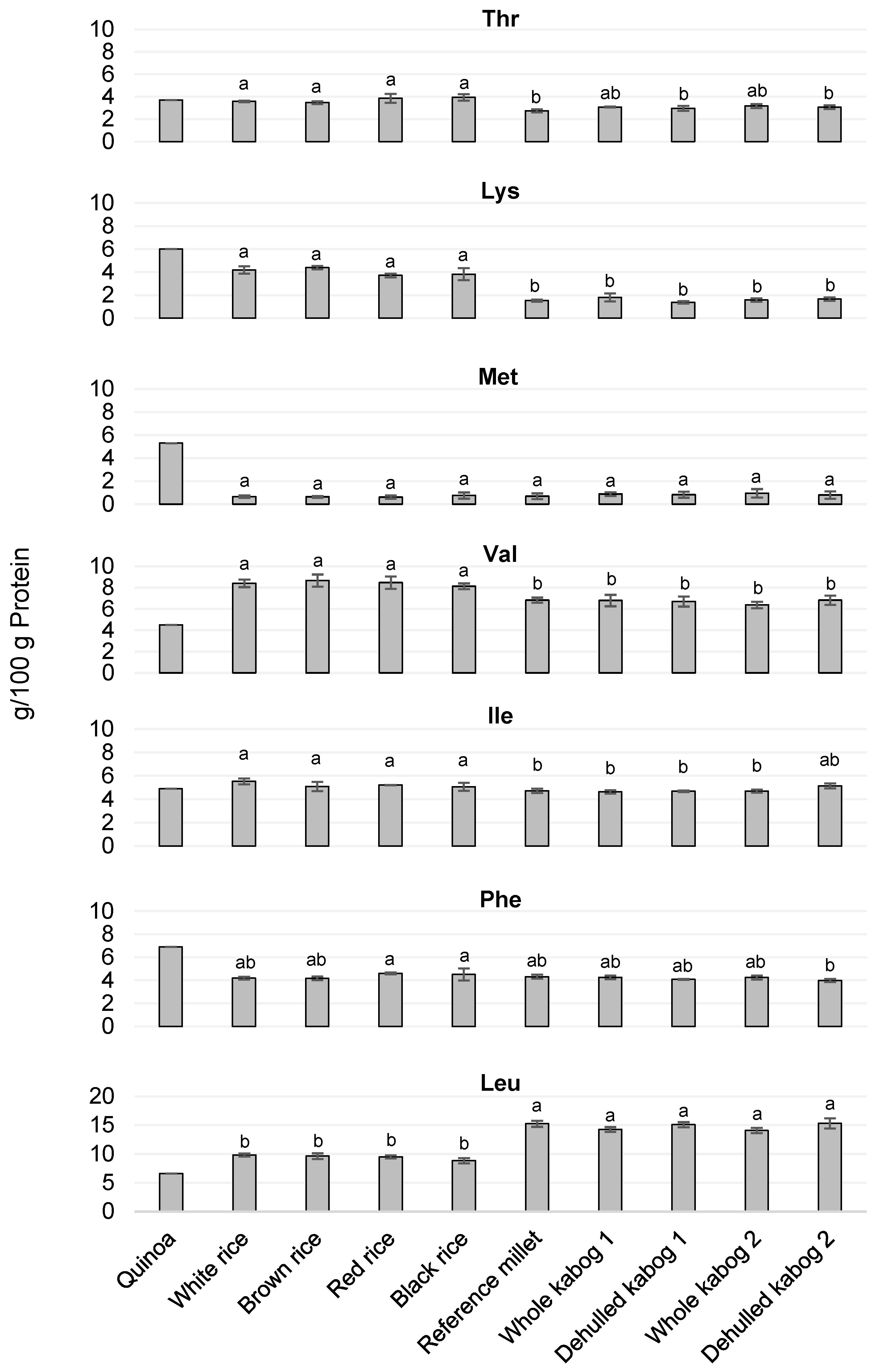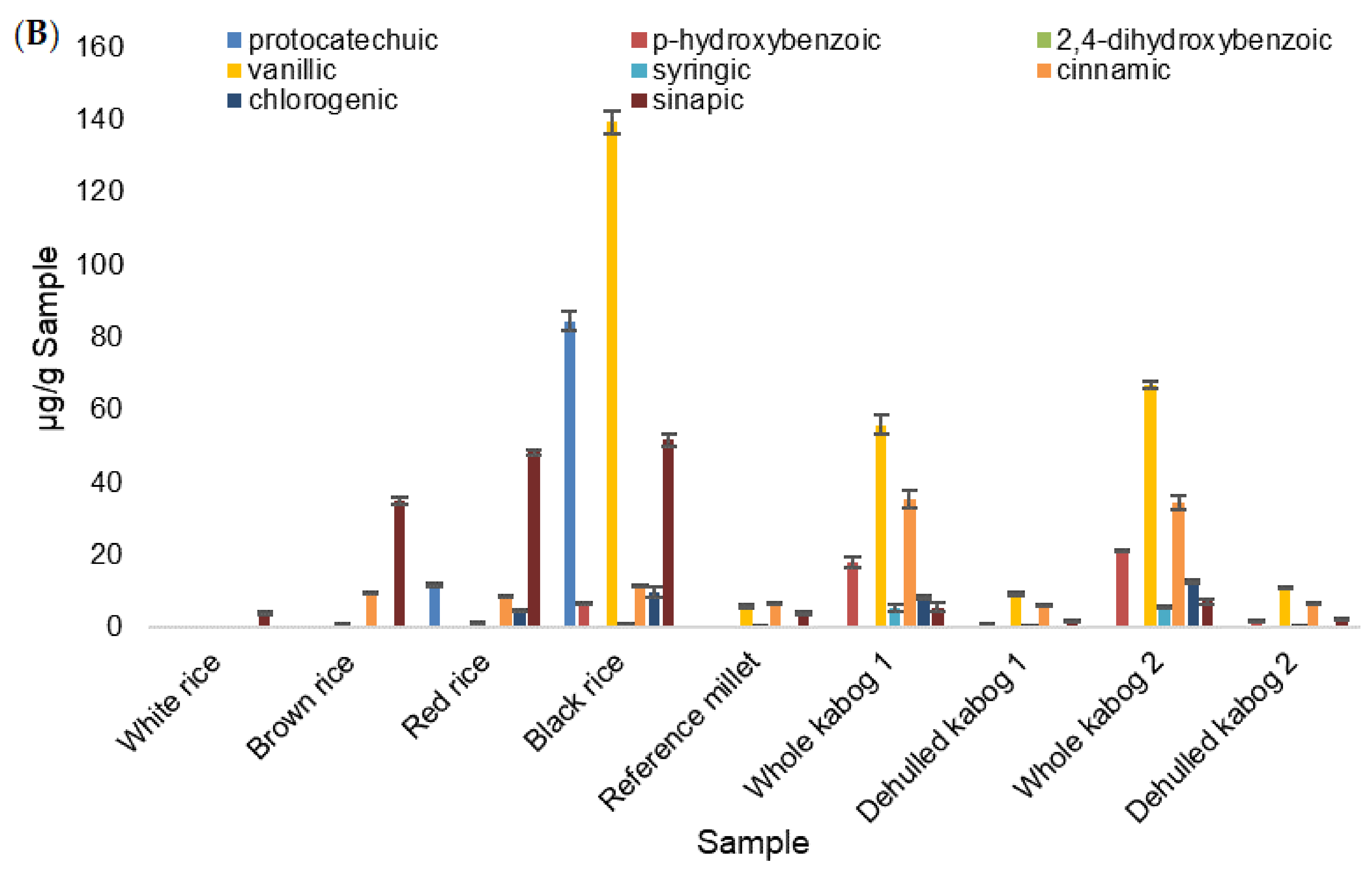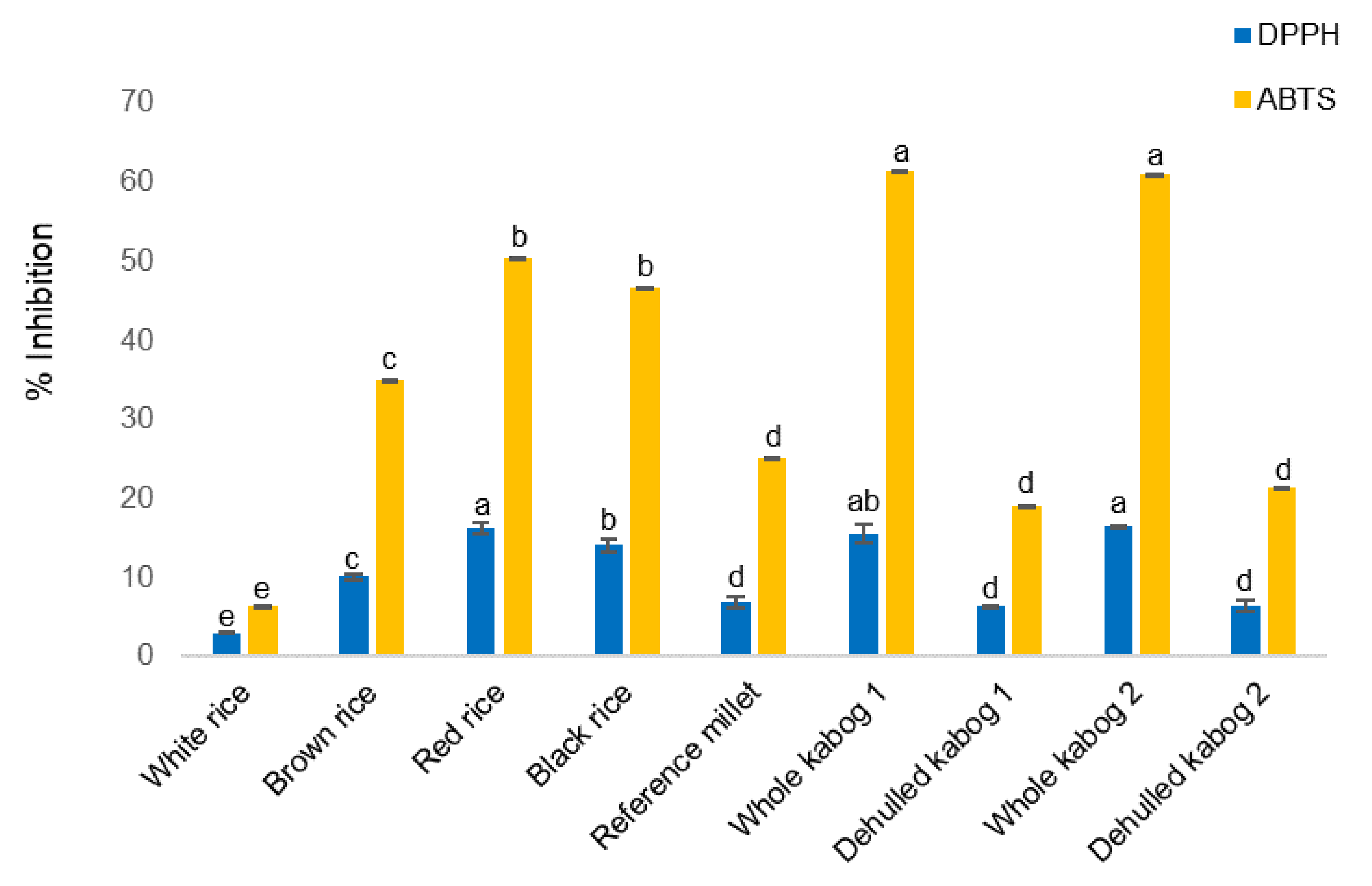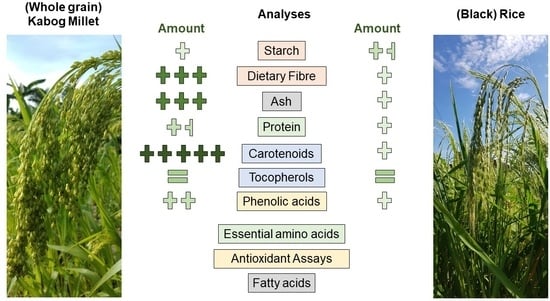Breathing New Life to Ancient Crops: Promoting the Ancient Philippine Grain “Kabog Millet” as an Alternative to Rice
Abstract
1. Introduction
2. Materials and Methods
2.1. Samples
2.2. Grinding
2.3. Nutritional Content Analysis
2.3.1. Starch, % Amylose, Dietary Fibre
2.3.2. Ash
2.3.3. Total Protein, Amino Acid Profiling
2.3.4. Carotenoids
2.3.5. Tocopherols
2.3.6. Phenolic Acids
2.3.7. Antioxidant Assays
2.3.8. Fatty Acid Methyl Esters (FAME)
2.4. Statistical Analysis
3. Results
3.1. Starch
3.2. Dietary Fibre and Ash
3.3. Protein and Essential Amino Acids
3.4. Carotenoids
3.5. Tocopherols
3.6. Phenolic Acids
3.7. Antioxidant Activity
3.8. Fatty Acid Methyl Esters (FAME)
4. Discussion
Limitations to the Study
5. Conclusions
Supplementary Materials
Author Contributions
Funding
Acknowledgments
Conflicts of Interest
References
- CFF: Crops for the Future. Available online: http://www.cffresearch.org/default.aspx (accessed on 1 April 2020).
- Borbon, S.M.S. In situ Characterization of Millet Cultivars Grown in Cebu, Philippines: Crop improvement Proposals. Unpublished. Ph.D. Thesis, Cebu Technological University, Cebu, Philippines, 2011. [Google Scholar]
- Slow Food Foundation for Biodiversity. Available online: https://www.fondazioneslowfood.com/en/ark-of-taste-slow-food/kabog-millet/ (accessed on 1 April 2020).
- Parameswaran, K.; Sadasivam, S. Changes in the carbohydrates and nitrogenous components during germination of proso millet (Panicum miliaceum). Plant Foods Hum. Nutr. 1994, 45, 97–102. [Google Scholar] [CrossRef]
- Saleh, A.S.; Zhang, Q.; Chen, J.; Shen, Q. Millet Grains: Nutritional Quality, Processing, and Potential Health Benefits. Compr. Rev. Food Sci. Food Saf. 2013, 12, 281–295. [Google Scholar] [CrossRef]
- Mal, B.; Padulosi, S.; Ravi, S.B. Minor Millets in South Asia: Learnings from IFAD-NUS Project in India and Nepal; Bioversity International: Rome, Italy; Swaminathan Research Foundation: Chennai, India, 2010; pp. 1–185. [Google Scholar]
- Singh, P.; Raghuvanshi, R.S. Finger millet for food and nutritional security. Afr. J. Food Sci. 2012, 6, 77–84. [Google Scholar] [CrossRef]
- Zhang, H.; Dotson, P. The use of microwave muffle furnace for dry ashing plant tissue samples. Commun. Soil Sci. Plant Anal. 1994, 25, 1321–1327. [Google Scholar] [CrossRef]
- FAO/INFOODS e-Learning Course on Food Composition Data. Available online: http://www.fao.org/elearning/Course/FCD/en/pdf/1151_factors_for_the_conversion_of_nitrogen_values_to_protein.pdf (accessed on 1 April 2020).
- Wallace, J.C.; Lopes, M.A.; Paiva, E.; Larkins, B.A. Methods for Extraction and Quantitation of Zeins Reveal a High Content of γ-Zein in Modified opaque-2 Maize. Plant Physiol. 1990, 92, 191–196. [Google Scholar] [CrossRef] [PubMed]
- Abdel-Aal, E.M.; Young, J.C. Carotenoids. In Healthgrain Methods. Analysis of Bioactive Components in Small Grain Cereals; Ward, J., Shewry, P.R., Eds.; AACC: St. Paul, MN, USA, 2010; pp. 69–94. [Google Scholar]
- Lampi, A.M.; Piironen, V. Tocopherols and Tocotrienols. In Healthgrain Methods. Analysis of Bioactive Components in Small Grain Cereals; Ward, J., Shewry, P.R., Eds.; AACC: St. Paul, MN, USA, 2010; pp. 15–24. [Google Scholar]
- Li, L.; Harflett, C.; Beale, M.; Ward, J. Phenolic acids. In Healthgrain Methods. Analysis of Bioactive Components in Small Grain Cereals; Ward, J., Shewry, P.R., Eds.; AACC: St. Paul, MN, USA, 2010; pp. 41–52. [Google Scholar]
- Zhu, D.; Sanchez-Ferrer, A.; Nyström, L. Antioxidant Activity of Individual Steryl Ferulates from Various Cereal Grain Sources. J. Nat. Prod. 2016, 79, 308–316. [Google Scholar] [CrossRef]
- Koziol, M. Chemical composition and nutritional evaluation of quinoa (Chenopodium quinoa Willd.). J. Food Compos. Anal. 1992, 5, 35–68. [Google Scholar] [CrossRef]
- Casey, P.; Lorenz, K. Millet—Functional and nutritional properties. Bak. Dig. 1977, 51, 45. [Google Scholar]
- Li, E.; Dhital, S.; Hasjim, J. Effects of grain milling on starch structures and flour/starch properties. Starch Stärke 2013, 66, 15–27. [Google Scholar] [CrossRef]
- Juliano, B.O. Rice in Human Nutrition; Food and Agriculture Organization of the United Nations: Rome, Italy, 1993; Available online: http://books.irri.org/9251031495_content.pdf (accessed on 29 March 2020).
- Saleh, A.; Wang, P.; Wang, N.; Yang, L.; Xiao, Z. Brown Rice Versus White Rice: Nutritional Quality, Potential Health Benefits, Development of Food Products, and Preservation Technologies. Compr. Rev. Food Sci. Food Saf. 2019. [Google Scholar] [CrossRef]
- Gopinath, D.; Naidu, A. A comparative study on starch digestibility, glycemic index and resistant starch of pigmented (‘Njavara’ and ‘Jyothi’) and a non-pigmented (‘IR 64’) rice varieties. J. Food Sci. Technol. 2010, 47, 644–649. [Google Scholar] [CrossRef]
- Thuengtung, S.; Niwat, C.; Tamura, M.; Ogawa, Y. In vitro examination of starch digestibility and changes in antioxidant activities of selected cooked pigmented rice. Food Biosci. 2018, 23, 129–136. [Google Scholar] [CrossRef]
- Zhu, L.J.; Liu, Q.Q.; Wilson, J.D.; Gu, M.M.; Shi, Y.C. Digestibility and physicochemical properties of rice (Oryza sativa L.) flours and starches differing in amylose content. Carbohydr. Polym. 2011, 86, 1751–1759. [Google Scholar] [CrossRef]
- Zhang, L.; Liu, R.; Niu, W. Phytochemical and antiproliferative activity of proso millet. PLoS ONE 2014, 9, e104058. [Google Scholar] [CrossRef]
- Juliano, B.O. Structure, chemistry, and function of the rice grain and its fractions. Cereal Foods World 1992, 37, 772–779. [Google Scholar]
- Yang, Q.; Zhang, P.; Qu, Y.; Gao, X.; Liang, J.; Yang, P.; Feng, B. Comparison of physicochemical properties and cooking edibility of waxy and non-waxy proso millet (Panicum miliaceum L.). Food Chem. 2018, 257, 271–278. [Google Scholar] [CrossRef]
- Cheng, A.; Ismail, I.; Osman, M.; Hashim, H. Simple and rapid molecular techniques for identification of amylose levels in rice varieties. Int. J. Mol. Sci. 2012, 13, 6156–6166. [Google Scholar] [CrossRef]
- Fernando, W. Rice as a Source of Fibre. J. Rice Res. 2013, 1, 2. [Google Scholar] [CrossRef]
- Food and Agriculture Organisation. Rice and Human Nutrition; International Year of Rice; Food and Agriculture Organization of the United Nations: Rome, Italy, 2004. Available online: http://www.unis.unvienna.org/documents/unis/calendar/year_of_rice/factsheet3.pdf (accessed on 29 March 2020).
- Moongngarm, A. Chemical compositions and resistant starch content in starchy foods. Am. J. Agric. Biol. Sci. 2013, 8, 107–113. [Google Scholar] [CrossRef]
- Young, V.R.; Pellett, P.L. Plant proteins in relation to human protein and amino acid nutrition. Am. J. Clin. Nutr. 1994, 59, 1203S–1212S. [Google Scholar] [CrossRef]
- Ufaz, S.; Galili, G. Improving the Content of Essential Amino Acids in Crop Plants: Goals and Opportunities. Plant Physiol. 2008, 147, 954–961. [Google Scholar] [CrossRef]
- Varzakas, T.; Zakynthinos, G. Carotenoids: From Plants to Food Industry. Curr. Res. Nutr. Food Sci. 2016, 4, 38–51. [Google Scholar] [CrossRef]
- Asharani, V.T.; Jayadeep, A.; Malleshi, N.G. Natural Antioxidants in Edible Flours of Selected Small Millets. Int. J. Food Prop. 2010, 13, 41–50. [Google Scholar] [CrossRef]
- Shammugasamy, B.; Ramakrishnan, Y.; Ghazali, H.M.; Muhammad, K. Tocopherol and tocotrienol contents of different varieties of rice in Malaysia. J. Sci. Food Agric. 2015, 95, 672–678. [Google Scholar] [CrossRef] [PubMed]
- Chandrasekara, A.; Naczk, M.; Shahidi, F. Effect of processing on the antioxidant activity of millet grains. Food Chem. 2012, 133, 1–9. [Google Scholar] [CrossRef]
- Bunzel, M.; Ralph, J.; Marita, M.J.; Hatfield, R.D.; Steinhart, H. Diferulates as structural components in soluble and insoluble cereal dietary fibre. J. Sci. Food Agric. 2001, 81, 653–660. [Google Scholar] [CrossRef]
- Anson, N.M.; van den Berg, R.; Havenaar, R.; Bast, A.; Haenen, G.R.M.M. Bioavailability of ferulic acid is determined by its bioaccessibility. J. Cereal Sci. 2009, 49, 296–300. [Google Scholar] [CrossRef]
- Boz, H. p-Coumaric acid in cereals: Presence, antioxidant and antimicrobial effects. Int. J. Food Sci. Technol. 2015, 50, 2323–2328. [Google Scholar] [CrossRef]
- Duodu, G. Effects of Processing on Antioxidant Phenolics of Cereal and Legume Grains; ACS Publications: Washington, DC, USA, 2011; Volume 1089, pp. 31–54. [Google Scholar] [CrossRef]
- Shao, Y.; Hu, Z.; Yu, Y.; Mou, R.; Zhu, Z.; Beta, T. Phenolic acids, anthocyanins, proanthocyanidins, antioxidant activity, minerals and their correlations in non-pigmented, red, and black rice. Food Chem. 2018, 239, 733–741. [Google Scholar] [CrossRef]
- Ratseewo, J.; Warren, F.J.; Siriamornpun, S. The influence of starch structure and anthocyanin content on the digestibility of Thai pigmented rice. Food Chem. 2019, 298, 124949. [Google Scholar] [CrossRef]
- Camelo-Méndez, G.A.; Agama-Acevedo, E.; Sanchez-Rivera, M.M.; Bello-Pérez, L.A. Effect on in vitro starch digestibility of Mexican blue maize anthocyanins. Food Chem. 2016, 211, 281–284. [Google Scholar] [CrossRef] [PubMed]
- Chandrasekara, A.; Shahidi, F. Inhibitory Activities of Soluble and Bound Millet Seed Phenolics on Free Radicals and Reactive Oxygen Species. J. Agric. Food Chem. 2011, 59, 428–436. [Google Scholar] [CrossRef] [PubMed]
- Marnett, L.J. Peroxyl free radicals: Potential mediators of tumor initiation and promotion. Carcinogenesis 1987, 8, 1365–1373. [Google Scholar] [CrossRef] [PubMed]
- Slavin, J. Whole grains and human health. Nutr. Res. Rev. 2004, 17, 99–110. [Google Scholar] [CrossRef] [PubMed]
- Annor, G.A. Millet Starches: Structural Characteristics and Glycemic Attributes. Ph.D. Thesis, University of Guelph, Guelph, ON, Canada, 2013. [Google Scholar]
- Bora, P.; Ragaee, S.; Marcone, M. Characterisation of several types of millets as functional food ingredients. Int. J. Food Sci. Nutr. 2019, 70, 714–724. [Google Scholar] [CrossRef]
- Lim, T.K. Setaria italica. In Edible Medicinal and Non-Medicinal Plants; Springer: Dordrecht, The Netherlands, 2013. [Google Scholar] [CrossRef]
- Biesiekierski, J.R. What is gluten? J. Gastroenterol. Hepatol. 2017, 32, 78–81. [Google Scholar] [CrossRef]
- Molina-Infante, J.; Santolaria, S.; Montoro, M.; Esteve, M.; Fernández-Bañares, F. Sensibilidad al gluten no celiaca: Una revisión crítica de la evidencia actual. Gastroenterol. Hepatol. 2014, 37, 362–371. [Google Scholar] [CrossRef]
- Coda, R.; di Cagno, R.; Rizzello, C.G.; Nionelli, L.; Edema, M.O.; Gobbetti, M. Utilization of African Grains for Sourdough Bread Making. J. Food Sci. 2011, 76, M329–M335. [Google Scholar] [CrossRef]
- Pontonio, E.; Rizzello, C.G. Chapter 35—Minor and Ancient Cereals: Exploitation of the Nutritional Potential Through the Use of Selected Starters and Sourdough Fermentation. In Flour and Breads and Their Fortification in Health and Disease Prevention, 2nd ed.; Preedy, V.R., Watson, R.R., Eds.; Academic Press: Cambridge, MA, USA, 2019; pp. 443–452. [Google Scholar] [CrossRef]
- Mezemir, S. Probiotic potential and nutritional importance of teff (Eragrostis tef (Zucc) Trotter) Enjerra—A review. Afr. J. Food Agric. Nutr. Dev. 2015, 15, 9964–9981. [Google Scholar]
- Carbó, R.; Gordún, E.; Fernández, A.; Ginovart, M. Elaboration of a spontaneous gluten-free sourdough with a mixture of amaranth, buckwheat, and quinoa flours analyzing microbial load, acidity, and pH. Food Sci. Technol. Int. 2020, 26, 344–352. [Google Scholar] [CrossRef]
- Moroni, A.V.; dal Bell, F.; Arendt, E.K. Sourdough in gluten-free bread-making: An ancient technology to solve a novel issue? Food Microbiol. 2009, 26, 676–684. [Google Scholar] [CrossRef] [PubMed]
- Osman, M.A. Changes in sorghum enzyme inhibitors, phytic acid, tannins and in vitro protein digestibility occurring during Khamir (local bread) fermentation. Food Chem. 2004, 88, 129–134. [Google Scholar] [CrossRef]





| Samples 1 | Total Starch | % Amylose | Dietary Fibre | Ash | Protein 2 (g/100 g) |
|---|---|---|---|---|---|
| White rice | 81.5 ± 0.7 a | 16.5 ± 1.6 b | 1.0 ± 0.4 c | 0.3 ± 0.0 g | 6.4 ± 0.0 h |
| Brown rice | 76.2 ± 1.0 a | 18.4 ± 0.1 b | 4.3 ± 0.7 b | 1.3 ± 0.0 d | 7.2 ± 0.0 g |
| Red rice | 71.8 ± 1.9 b | 18.7 ± 1.1 b | 5.6 ± 0.7 b | 1.3 ± 0.0 d | 8.0 ± 0.0 f |
| Black rice | 72.6 ± 2.1 b | 16.5 ± 0.6 b | 5.0 ± 0.5 b | 1.6 ± 0.0 c | 8.4 ± 0.0 e |
| Reference millet | 72.3 ± 0.2 b | 42.3 ± 1.9 a | 4.4 ± 0.7 b | 1.1 ± 0.0 e | 11.1 ± 0.1 d |
| Whole kabog 1 | 51.6 ± 1.8 d | 16.4 ± 1.1 b | 14.6 ± 0.6 a | 4.2 ± 0.0 a | 12.0 ± 0.0 c |
| Dehulled kabog 1 | 60.1 ± 2.7 c | 19.1 ± 1.8 b | 3.6 ± 0.6 b | 1.0 ± 0.0 f | 12.5 ± 0.0 b |
| Whole kabog 2 | 47.4 ± 2.0 d | 18.1 ± 1.0 b | 13.8 ± 0.9 a | 4.1 ± 0.1 b | 12.1 ± 0.0 c |
| Dehulled kabog 2 | 63.2 ± 1.7 c | 10.7 ± 1.3 c | 4.0 ± 1.1 b | 1.1 ± 0.0 e | 12.9 ± 0.1 a |
| Samples 1 | Carotenoids | Phenolic Acids | Tocopherols |
|---|---|---|---|
| White rice | 0.2 ± 0.0 (2) e | 93.9 ± 2.3 f | 10.8 ± 0.1 d |
| Brown rice | 0.9 ± 0.0 (2) e | 467.5 ± 7.0 d | 52.7 ± 1.7 c |
| Red rice | 1.0 ± 0.0 (2) e | 433.0 ± 4.8 d | 58.2 ± 4.5 c |
| Black rice | 3.5 ± 0.1 d | 707.0 ± 13.9 c | 120.0 ± 15.7 a |
| Reference millet | 6.9 ± 0.5 c | 298.0 ± 2.0 e | 37.2 ± 2.0 c,d |
| Whole kabog 1 | 16.8 ± 0.4 b | 1519.0 ± 47.1 b | 93.1 ± 9.0 b |
| Dehulled kabog 1 | 19.4 ± 0.3 a | 264.7 ± 5.4 e | 45.0 ± 5.3 c |
| Whole kabog 2 | 15.7 ± 0.6 b | 1606.6 ± 16.2 a | 99.4 ± 9.4 a,b |
| Dehulled kabog 2 | 19.3 ± 0.5 a | 320.8 ± 0.3(2) e | 50.4 ± 6.3 c |
| Sample 1 | CEAC (ABTS) | TEAC (ORAC) |
|---|---|---|
| White rice | 141.9 ± 30.5 e | 173.6 ± 2.3 d |
| Brown rice | 799.7 ± 49.4 c | 1104.2 ± 52.4 c |
| Red rice | 1158.2 ± 79.4 b | 1312.9 ± 35.3 a,b |
| Black rice | 1068.8 ± 75.8 b | 1439.2 ± 61.9 a |
| Reference millet | 574.2 ± 16.6 d | 1217.9 ± 44.0 b,c |
| Whole kabog 1 | 1409.9 ± 60.2 a | 1456.4 ± 14.0 a |
| Dehulled kabog 1 | 433.4 ± 19.3 d | 1234.2 ± 70.9 b,c |
| Whole kabog 2 | 1410.7 ± 78.8 a | 1432.3 ± 56.8 a |
| Dehulled kabog 2 | 502.4 ± 40.3 d | 1160.5 ± 2.9 b,c |
Publisher’s Note: MDPI stays neutral with regard to jurisdictional claims in published maps and institutional affiliations. |
© 2020 by the authors. Licensee MDPI, Basel, Switzerland. This article is an open access article distributed under the terms and conditions of the Creative Commons Attribution (CC BY) license (http://creativecommons.org/licenses/by/4.0/).
Share and Cite
Narciso, J.O.; Nyström, L. Breathing New Life to Ancient Crops: Promoting the Ancient Philippine Grain “Kabog Millet” as an Alternative to Rice. Foods 2020, 9, 1727. https://doi.org/10.3390/foods9121727
Narciso JO, Nyström L. Breathing New Life to Ancient Crops: Promoting the Ancient Philippine Grain “Kabog Millet” as an Alternative to Rice. Foods. 2020; 9(12):1727. https://doi.org/10.3390/foods9121727
Chicago/Turabian StyleNarciso, Joan Oñate, and Laura Nyström. 2020. "Breathing New Life to Ancient Crops: Promoting the Ancient Philippine Grain “Kabog Millet” as an Alternative to Rice" Foods 9, no. 12: 1727. https://doi.org/10.3390/foods9121727
APA StyleNarciso, J. O., & Nyström, L. (2020). Breathing New Life to Ancient Crops: Promoting the Ancient Philippine Grain “Kabog Millet” as an Alternative to Rice. Foods, 9(12), 1727. https://doi.org/10.3390/foods9121727






